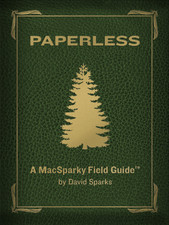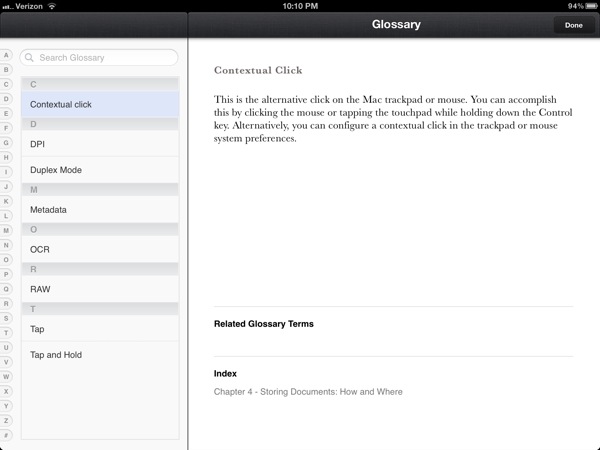Paperless is More Than Paper

I've accepted that eBooks are the future of reading. I say "accepted" because I was once a trophy reader. I prided myself on displaying the spoils of reading. I still have a large library of books on wood-pulp but I've abandoned them to their fate in my attic. There are thousands of books up there.
I stopped valuing the atoms in exchange of the ideas. The pleasure I once felt perusing my taxidermied collection of first editions and rare prints has been overwhelmed by the memories of moving boxes and cramped apartments.
eBooks offer a future where words are treasured more than the ink and paper they are held on, where reading is done for the pleasure of the content, not for the collection.1
But this article2 is not about eBooks. It is about Paperless by David Sparks. This article is also not a review of Paperless. The best review I can give is that it is a work of extraordinary craftsmanship by an expert in the field. It is a how-to guide for keeping digital records.
Paperless
Rather than write a review of the ideas and proposals in Paperless, I want to talk about what Paperless represents. Paperless is part of the future that Apple promised with iBooks Author. It is more than a book. It is a knowledge application. Paperless can only be roughly construed as a book in broad terms. The material is organized into chapters. There are words laid out on a facsimile of a page. There is an introduction and a Table of Contents. Other than that, Paperless differs from a book in almost every important way.
Paperless is designed as a personal teacher. Each chapter is cemented by David's words on the "page" but half of the valuable material is in the interactive videos and slide shows. David is an excellent writer but anyone familiar with his talents for demonstrating software and workflows will not be surprised by the quality of the training videos in Paperless.
The Little Touches
Each video is concise and settles immediately into the point. The vignettes are the perfect length and style to be used in the initial read-through or as a refresher during a review.
While the videos are short, there are many of them. Every chapter has 5 or more self contained instructional clips. I think this is key to the ongoing value of the book. Since each vignette is self contained, there is no need to go back and read the entire chapter to get the appropriate context. That means it's not a throw-away one time read. That means it is not just like a web page.3
David's eBook is more than a collection of embedded videos. He has taken the time and effort to add style throughout. Even some of the slideshows are interactive. In the example below, David calls out each part of his file naming recommendation.
Is this superfluous? Probably. However, it's a nice touch that adds to the pleasure of reading. It also focuses the readers attention on something the author thinks is important. In fact David refers repeatedly to the importance of a good file naming scheme. In a small way, offering the interactive clip says "Hey you! This is really important. Don't just speed read past it. Don't just mindlessly watch the video. There will be a quiz."4
Publishing
David self-published Paperless. I don't know the details but I do know that to use these screenshots and videos, I only needed to email David. There was no release form. There was no review process (other than me asking politely). There was no middleman. David's book represents something I like a lot. Authors that own every aspect of their work.
Quibbles
I only have one minor quibble about Paperless. The Glossary and Index are sparse. I say "minor" because eBooks provide something that paper can not: quick and accurate search. In a way, a Glossary and Index are unnecessary in an eBook. Some old pleasures die hard. I still enjoy browsing a good index. I still enjoy randomly flipping to a page in a book and exploring.

Conclusion
If you just skipped to the end, here's the take-home: Paperless can be completed in one evening. It's full of great advice that I may have already heard or read elsewhere. For a measly $5 I get all of the stuff prettied up, filtered and organized by an expert. I also get David's thoughtful planning and demonstration. Paperless is just a collection of tips and tricks, like a lighthouse is just a porch light. Sometimes a book is more than its parts.
-
Take it easy. Don't get your undies in a knot. It's ok to take pleasure in a nicely bound book. I still treasure some first editions. But in the end, those treasures are few and far between. They are much fewer than most book collectors appreciate. ↩
-
I know this post is "late" in terms of Internet time. Most reputable sites posted about the book while the electrons were still warm. I wanted to take my time and read the entire thing. I wanted to enjoy the book and see where it took me. ↩
-
I'm not going to kid anyone. There's a lot of stuff in my Pinboard bookmarks that I will never remember to re-visit. Having it all bound in one place like an eBook means I will know where to go for a refresher. ↩
-
There is no quiz, other than the one that a life of digital records foists on all of us. Failing that quiz hurts. ↩
